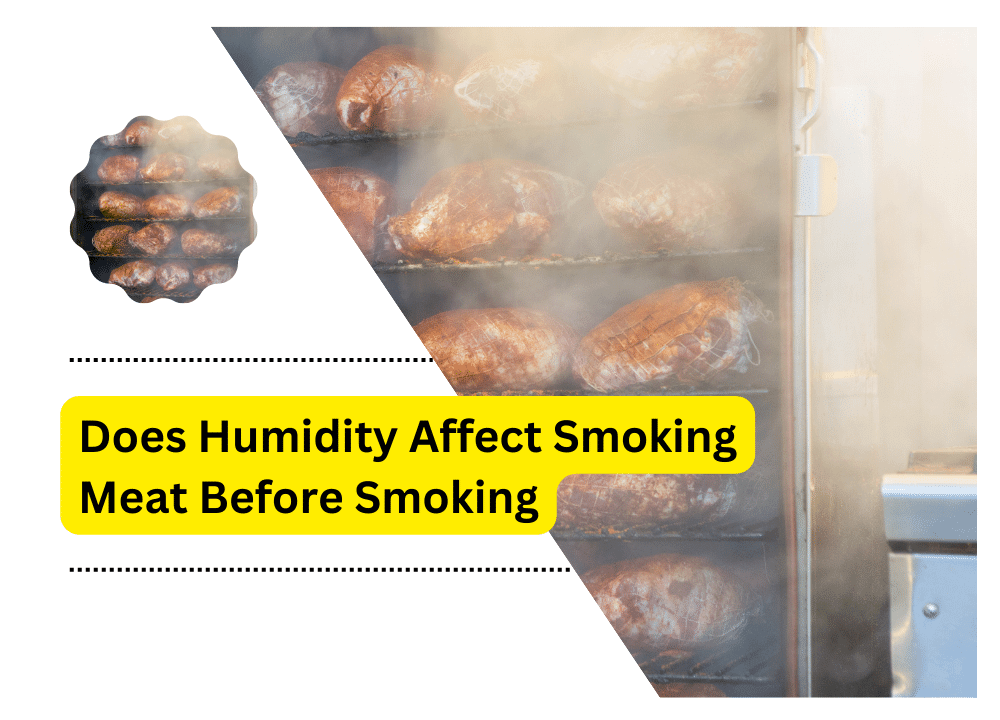
Smoking meat involves using low temperatures over a long period to cook and flavor the food. While this technique is ancient, its intense flavors have recently gained popularity. The process requires particular conditions for optimal results, with humidity being one of them. Does humidity affect smoking meat? Let’s take a closer look.
Humidity and Smoking Meat
Humidity plays an essential role in smoking because it affects how food cooks and absorbs smoke. High humidity slows down the cooking of food. It, in turn, necessitates more time to reach the desired temperature for a meal. Low humidity can help the food cook faster but also make it too dry and cause it to lose its smoke flavor.
The ideal humidity for smoking meat is between 45%-55%. This range allows the food to cook while still absorbing the smoke flavoring. To help maintain this humidity level, some smokers will use a wet towel or pan of water near the heat source. The towel helps add moisture to the air and prevents it from drying out.
Humidity Management Techniques in Meat Smoking
When smoking meat, you can use several techniques to achieve the ideal humidity range.
Using a smoker box or a wet towel
One of the most popular is using a smoker box or a wet towel to add moisture to the air. A smoker box creates smoke and helps keep the temperature and humidity at the desired levels.
Adding water pans to the smoker
Another popular technique is adding water pans to the smoker. Water pans can add moisture to the air and help maintain optimal humidity. For best results, place them near the heat source. It will ensure the water pans evaporate and provide moisture to the surrounding air.
Finally, some smokers may opt to use a combination of all techniques to achieve optimal results. Using the proper techniques, smokers can ensure that their meats come out juicy and flavorful every time.
Considerations for Different Types of Meat
Does humidity affect smoking meat – The general rules for smoking meat remain consistent. There are certain factors you need to consider when dealing with different types of meat. For instance, pork and poultry need higher temperatures than beef or lamb. It implies that you should maintain a lower humidity level than you would for other meats. Achieving the proper cooking temperature for these specific types of meats is necessary.
Additionally, poultry should be closely monitored when smoking because it can dry. To prevent this, the smoker should try to keep the humidity level between 50%-60% for poultry.
Finally, never smoke fish at temperatures above 140 degrees Fahrenheit. It tends to become too dry and overcooked. Keeping the humidity levels around 50% is essential. It ensures that fish does not get overcooked.
Factors Affecting Humidity Levels in Smoking
When smoking meat, several factors can affect the humidity levels in the smoker.
The type and size of the smoker
The type and size of the smoker you’re using, and external environmental factors such as wind and temperature will all play a role.
The shape of the smoker
The size and shape of the smoker will determine the amount of water you need to add to maintain proper humidity levels. Additionally, wind can cause the smoker to dry quickly. So, make sure to place the smoker in an area with minimal wind.
The temperature of the smoker
Finally, temperature will also affect the levels of humidity in a smoker. Higher temperatures can cause the smoke to evaporate faster than normal. It can make it difficult to maintain proper humidity levels. For this reason, it’s important to ensure the smoker is set to the correct temperature before smoking.
FAQs
A: Yes, humidity does play an important role in smoking meat. High humidity levels can cause the smoke to linger around for a longer time and permeate into the meat more deeply. On the other hand, low levels of humidity will cause the smoke to quickly dissipate and not stay around as long.
A: You can use several techniques to maintain the correct humidity when smoking meat. These techniques include using a smoker box or wet towel, adding water pans, and combining all three techniques.
A: Yes, different types of meat need different moisture levels to achieve the ideal humidity level. For instance, pork and poultry need higher temperatures than beef or lamb. As a result, you should keep the humidity lower.
A: Wind, temperature and the size and shape of the smoker can all affect the humidity levels in a smoker. If wind is present, it can cause the smoker to dry out. So, it’s important to make sure that you place the smoker in an area with minimal wind.
A: If your smoker is not reaching the desired humidity level, add a wet towel or pan of water near the heat source. It will help add moisture to the air and prevent it from drying out, ensuring optimal results.
Conclusion
Does humidity affect smoking meat – Humidity is important in meat smoking and can affect its flavor and texture. Keeping humidity levels between 45%-55% is key for optimal results. To help maintain this level, smokers may use a wet towel, smoker box, or water pans near the heat source.
Several factors can affect the humidity levels, such as the size and shape of the smoker and temperature. By considering all these elements, smokers can ensure that their meat always comes out juicy and flavorful.
